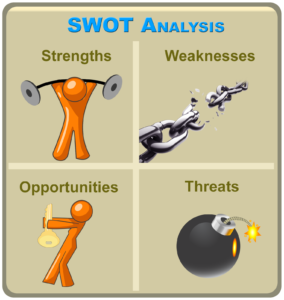Conducting SWOT analysis (identifying an organization’s Strengths, Weaknesses, Opportunities, Threats) is one of the most commonly used activities in strategic planning. It is also an activity most often done poorly. Here are three ideas to improve your SWOTing:
 1. Be Systematic. Don’t just ask people on your strategic planning committee what they think your SWOTs are. Use an assessment tool or framework so that you can systematically think through your SWOTs. For organization assessments, you can read more here about the VPP/McKinsey assessment tool and for Board Assessment you can learn more hereabout a tool from BoardSource.
1. Be Systematic. Don’t just ask people on your strategic planning committee what they think your SWOTs are. Use an assessment tool or framework so that you can systematically think through your SWOTs. For organization assessments, you can read more here about the VPP/McKinsey assessment tool and for Board Assessment you can learn more hereabout a tool from BoardSource.
2. Seek External Input. Go beyond your strategic planning group to solicit SWOTs. What does the staff think, what do donors think, what do your clients think? You want to get a divergence of ideas and perspectives. Make sure to collect environmental data from external sources so you can consider facts, not just opinions.
3. Get Relevant. When you decide which SWOTs are most important to keep in mind during strategy formulation, challenge yourselves on the relevance of each item. How will we leverage this Strength to move toward our goals and vision? How will fortifying this Weakness help us move forward? Why will seizing this Opportunity allow us to catapult ourselves into the future? What is it about this Threat that could derail us? If you cannot provide solid answers to these questions then the particular SWOT you are discussing is not relevant. Identify those that are.
Accurately identifying your SWOTs sets you up to identify strategic actions that will move you forward toward your goals and vision. Take the time to improve your SWOTing process so you can make an improved Mission Impact.